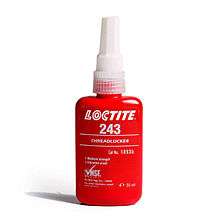Loctite
Loctite is a German-owned American brand of adhesives, sealants and surface treatments that include acrylic, anaerobic, cyanoacrylate, epoxy, hot melt, silicone, urethane and UV/light curing technologies. Loctite products are sold globally and are used in a variety of industrial and hobbyist applications.
 | |
| Product type |
|
|---|---|
| Owner | Henkel AG & Company, KGaA |
| Country | Düsseldorf, Germany |
| Introduced | 1956 |
| Markets | Worldwide |
| Website | loctite |

History
In 1953, American professor Vernon K. Krieble developed anaerobic threadlocking adhesives in his basement laboratory at Trinity College in Hartford, Connecticut. Krieble’s company, American Sealants, founded the Loctite brand, which was promoted as ushering in a new era of mechanical reliability by eliminating the vibrational loosening of mechanical fasteners, a frequent cause of machine failure.[1] In 1956, the name Loctite was chosen by Krieble’s daughter-in-law, Nancy Brayton Krieble.[2] The Loctite sealant made its official public debut at a press conference at the University Club of New York on July 26 of that year.
In 1963, American Sealants changed its name to the Loctite Corporation. After Vernon Krieble's death in 1964, his son Robert H. Krieble, also a chemist, served as chief executive until 1985. The Vernon K. Krieble Foundation was established in 1984 in honor of the co-founder.
In 1964, Loctite introduced cyanoacrylate adhesives (a repackaged Eastman product, developed at Tennessee Eastman/Eastman Chemical in 1942, and originally marketed as "Eastman 910"), later known as “Super Glue”.[3] It was the first of many new products, including silicones, epoxies, acrylics and the development of new Loctite anaerobics. The 1980s brought about the addition of a line of micro anaerobic adhesives.[4]
In 1997, Loctite was acquired as a flagship brand by Henkel, a German Fortune 500 company.[5] Since then, Loctite has remained a primary Henkel brand and a supplier of household adhesives, epoxies, spray adhesives, construction adhesives and home repair, sealants and fillers. In recent years, the company has increased its focus on green and sustainable technologies.[6]
Products
Products made with Loctite branding include:
- Bonding adhesives, such as cyanoacrylates,[7] epoxies[8] and hot melts[9]
- Protective coatings for industrial equipment[10]
- Flooring and concrete repair sealants and topcoats[11]
- Gasketing and sealing products[12]
- Industrial anti-seize and lubricating products[13]
- Machining compounds that supplement cutting, smoothing and finishing processes[14]
- Potting and encapsulating products to reinforce housed assemblies[15]
- Repairing, rebuilding and restoring[16]
- Retaining compounds for non-threaded cylindrical assemblies
- Surface preparation products such as cleaners and degreasers
- Threadlockers and thread sealants in anaerobic liquid and semi-solid formulations
- Medical applications (adhesives, dispensing equipment, curing systems)
- Adhesive equipment (controllers, reservoirs, applicators, valves, dispensing systems, pumps, monitoring systems).
- Solder pastes
References
- "Mechanical Fasteners". Henkel Corporation. Retrieved 14 August 2012.
- "Robert H. Krieble, 80, Dies; Was Co-Founder of Loctite". New York Times. NYTimes. Retrieved 2019-02-28.
- "Super Glue". Henkel Corporation. Retrieved 14 August 2012.
- "Anaerobic Adhesives". Henkel Corporation. Retrieved 14 August 2012.
- Staff, Times; Reports, Wire (1996-12-06). "Loctite Agrees to Merge With Henkel". Los Angeles Times. ISSN 0458-3035. Retrieved 2016-07-11.
- "Loctite History". Henkel Corporation. Retrieved 14 August 2012.
- "Cyanoacrylate Product Information". Henkel Corporation. Retrieved 15 August 2012.
- "Epoxy Product Information". Henkel Corporation. Retrieved 15 August 2012.
- "Hot Melts Product Information". Henkel Corporation. Retrieved 15 August 2012.
- "Industrial Coatings". Henkel Corporation. Retrieved 15 August 2012.
- "Flooring and Concrete Repair Sealants and Topcoats". Henkel Corporation. Retrieved 15 August 2012.
- "Gasketing and Sealing Product Information". Henkel Corporation. Retrieved 15 August 2012.
- "Industrial Anti-Seize and Lubricating Products". Henkel Corporation. Retrieved 15 August 2012.
- "Machining Compound Information". Henkel Corporation. Retrieved 14 August 2012.
- "Potting and Encapsulating". Henkel Corporation. Retrieved 14 August 2012.
- "Repairing, Rebuilding and Restoring Information". Henkel Corporation. Retrieved 14 August 2012.
Further reading
- The Loctite Story by Kenneth W. Butterworth. New York: Newcomen Society of the United States, 1988.
- Chapman, Peter, "Henkel Seeks Rest of Loctite in Adhesives Industry Push", Chemical Market Reporter, November 4, 1996, p. 1.
- Drop by drop: the Loctite story, 1953-1980, by Ellsworth S. Grant. Loctite Corp., 1983 LOC #83-80637.
- Giragosian, Newman H., "Successful Product & Business Development", New York: Marcel Dekker, Inc., 1978.
- Hulstein, Calvin, "Assembling with Anaerobics", Chemtech, October 1980.
- Kiesche, Elizabeth S., "Loctite Secures a Grip in a Broader Market; Applying Technology, Marketing Expertise Worldwide", Chemical Week, March 3, 1993, p. 37.
- McClenahen, John S., "Robert Krieble's Capitalist Crusade," Industry Week, April 6, 1992.
- Wantuck, Mary-Margaret, “Drop by drop, his firm won worldwide success; how Loctite became a leader in liquid adhesives”, Nation's Business, July 1984.
- Woods, Wilton, "Sticky Stuff", Fortune, March 6, 1995, p. 24.
External links
| Wikimedia Commons has media related to Loctite. |